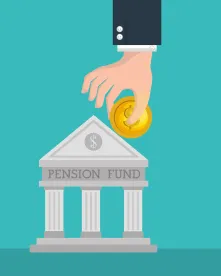Introduction
In late 2019, McClatchy Co., the second largest newspaper publisher in the United States, announced that it was facing a liquidity crunch, would be unable to make a required $124MM payment to its pension fund due in 2020, and was in discussions with the government regarding a pension fund bailout.1 On January 15, 2020, it was reported that McClatchy Co. failed to make a regularly scheduled $12MM interest payment and missed a pension payment to its retired executives. Although the McClatchy Co. developments are headline grabbing because of the sheer magnitude of the pension liability, more and more companies are facing liquidity pressures caused, at least in part, by continuing pension obligations.
Over the last several decades, there has been a distinct shift in private-sector pension plans.2 Companies are moving away from defined benefit plans to defined contribution plans. In 1975, there were 103,346 private-sector defined benefit plans compared to only 46,698 plans in 2017.3 The Bureau of Labor Statistics reported, in 2018, only an estimated "17% of private sector workers have access" to defined benefit plans.4 In fact, "[o]f the 200 biggest defined-benefit plans in the S&P 500 based on assets, 186 aren't fully funded."5 It is estimated those plans in the aggregate are underfunded by $342 billion.6
As more companies experience the burden of continuing to fund defined benefit pension plans, particularly plans that have been chronically underfunded, they are more often seeking legal advice to better understand their options.
ERISA and the PBGC
In 1974, the Employee Retirement Income Security Act (ERISA) was enacted "to protect interstate commerce and the interests of participants in employee benefit plans and their beneficiaries."7 ERISA also established guidelines regarding private-sector benefit plans and created the Pension Benefit Guaranty Corporation (PBGC), a federal agency created to protect and insure private pension benefits.8 Companies with defined benefit plans must purchase insurance from the PBGC.9 If a defined benefit plan becomes underfunded and can no longer be supported, the procedural framework set forth under ERISA permits a company to terminate a PBGC-insured defined benefit plan and shift pension obligations from the company to the PBGC.10 As a condition to terminating a defined benefit plan, the PBGC can assert one of three claims: (i) a claim for "the full amount of underfunded benefit liabilities; (ii) due and unpaid minimum funding contributions; and (iii) unpaid premiums to the PBGC."11
Absent Bankruptcy, There is Limited Ability to Terminate Single Employer Defined Benefit Plans
If a defined benefit plan has sufficient assets to pay all benefits owed to participants and beneficiaries, a company may terminate the plan following the "standard termination" process. In a standard termination, the PBGC does not become responsible for benefit payments after the plan's termination.
If a plan does not have sufficient assets to pay all benefits, a company that is not in bankruptcy may not terminate the plan unless the company has proved to the PBGC that, without terminating the defined benefit plan, (i) the company is "unable to pay debts when due" and is "unable to continue in business"; or (ii) "the costs of providing pension coverage have become unreasonably burdensome."12 This is a factually based process whereby the PBGC evaluates the information on a case-by-case basis.13 Ultimately, distress terminations are a "last resort" and it is the PBGC's goal to "keep employers that sponsor pension plans responsible for their own obligations."14
Standard for Terminating a Single Employer Defined Benefit Plan in Bankruptcy
The statutory and regulatory framework for termination of single employer defined benefit plans in the context of a Chapter 11 bankruptcy are provided in 29 U.S.C. § 1341 and 29 C.F.R. § 4041.41. After a company files for bankruptcy protection, the trustee or debtor-in-possession must direct the plan administrator to provide 60 days' notice to "each affected party" of the intent to terminate the plan and must file with the PBGC a distress termination notice.15 After the plan administrator delivers the notices, the PBGC will determine whether the company satisfies the "distress criteria" set forth below:16
-
as of the proposed termination date, the [company] has filed or has had filed against it, a petition for reorganization under the Bankruptcy Code;
-
the case has not, as of the proposed termination date, been dismissed;
-
the [company] has provided the PBGC any request for bankruptcy court approval of the termination; and
-
the bankruptcy court determines that, unless the plan is terminated, the employer will be unable to pay all of its debts pursuant to a Reorganization Plan and will be unable to continue in business outside the Chapter 11 reorganization process.17
Bankruptcy Settlements with the PBGC
To minimize litigation, the PBGC and the debtor-in-possession or trustee may enter into a settlement agreement or similar arrangement which sets forth the terms and conditions for terminating a defined benefit plan. Particularly in cases in which a defined benefit plan is underfunded, the settlement agreement will, in many cases, condition plan termination upon the PBGC receiving, in addition to plan assets, claims against the debtor's estate.
Companies that have Recently Terminated Single Employer Defined Benefit Plans in Bankruptcy
Avaya Inc.
In January 2017, Avaya Inc., a telecom company (in its capacity as a debtor-in-possession, the "Debtor"), filed for Chapter 11 bankruptcy.18 The Debtor had two "significantly underfunded pension plans insured by the PBGC."19 However, the Debtor only initiated a distress termination for The Avaya Inc. Pension Plan for Salaried Employees.20 The plan covered 8,000 participants and had assets of $1.5 billion, but was underfunded by $1.1 billion.21 Pursuant to a settlement agreement between the Debtor and the PBGC, termination of The Avaya Inc. Pension Plan for Salaried Employees was conditioned upon, among other things, the Debtor (a) delivering to the PBGC plan assets of approximately $1.5B; (b) paying to the PBGC an amount equal to $300MM; and (c) delivering to the PBGC 7.5% of the common stock of the reorganized company.
Sears Holdings Company
In October 2018, Sears Holdings Company (in its capacity as a debtor-in-possession, the "Debtor") filed for Chapter 11 bankruptcy.22 At the time of bankruptcy, the Debtor had two defined benefit plans that covered about 94,000 participants that were underfunded by an estimated $1 billion in aggregate.23 On January 29, 2019, the Debtor began the distress termination process and sent out notices of termination to plan participants.24 However, on February 1, 2019, the PBGC brought an action against the Debtor to initiate an involuntary termination because the Debtor had not met its statutory minimum funding requirement for the pension plans as required by ERISA.25 Pursuant to a settlement agreement between the Debtor and the PBGC, (a) the PBGC dismissed its involuntary termination; (b) the PBGC agreed to assume the Debtor's pension obligations under the two defined benefit plans; (c) the Debtor delivered to the PBCG all plan assets; (d) the PBGC was awarded an $800 million unsecured claim against the Debtor's estate; and (e) the Debtor's plan of reorganization provided the PBGC with a beneficial interest in a liquidating trust established pursuant to the Debtor's plan of reorganization.26
Wolverine Tube, Inc.
In late 2010, Wolverine Tube (in its capacity as a debtor-in-possession, the "Debtor") filed for Chapter 11 bankruptcy. The Debtor had a defined benefit pension plan that covered 2,332 participants.27 It was estimated the plan was underfunded by approximately $89,640,000.28 Pursuant to a Memorandum of Understanding between the Debtor and the PBGC, termination of the defined benefit plan was conditioned upon, among other things, the Debtor (a) delivering to the PBGC all plan assets; and (b) awarding the PBGC a claim against the Debtor's estate in an amount equal to $20MM which claim would be paid in full by the reorganized debtor over an 11 year period.29
Conclusion
The decline of single employer defined benefit plans continues apace. As companies feel the liquidity pinch from continuing obligations to fund defined benefit plans often set up by prior management in decades past, they are increasingly turning to counsel to understand their options. If you have a defined benefit pension plan and are interested in better understanding your options, please contact any of the authors.
1Lukas I. Alpert, McClatchy Misses Debt and Pension Payments as Negotiations With Creditors Continue, THE WALL STREET JOURNAL (January 15, 2020).
2Worker Participation in Employer-Sponsored Pensions: A Fact Sheet, CONGRESSIONAL RESEARCH SERVICE, (last updated April 30, 2019),.
3Private Pension Plan Bulletin Historical Tables and Graphs 1975-2017, US DEPARTMENT OF LABOR: EMPLOYEE BENEFITS SECURITY ADMINISTRATION (Sept. 2019).
4 James McWhinney, The Demise of the Defined-Benefit Plan, INVESTOPEDIA (Updated Dec. 1, 2019).
5 Brandon Kochkodin & Laurie Meisler, S&P 500's Biggest Pension Plans Face $382 Billion Funding Gap, BLOOMBERG (July 20, 2017).
6Id.
7 29 U.S.C.A. § 1001.
8General FAQs about PBGC, PENSION BENEFIT GUARANTY CORPORATION, (last visited Dec. 30, 2019) (Hereinafter General FAQs).
9Id.
10Distress Termination of Pension Plans in Chapter 11, AMERICAN BANKRUPTCY INSTITUTE (Mar. 2006); General FAQs, supra note 2.
11 Mitchell A. Seider et al., FAQ: Recent Developments in U.S. Law Affecting Pension and OPEB Claims in Restructuring, PRATT'S BANKRUPTCY LAW 389, 410 (Nov./Dec. 2015).
12 29 U.S.C. § 1341(c)(2)(B)(iii); 29 C.F.R. § 4041.41(c)3-4; How Pension Plans End, PBGC (last updated April 27, 2017); Standard Terminations, PBGC, (last visited Jan. 6, 2020).
13Staff Responses to Practitioner Questions, PBGC (last updated Feb. 1, 2019).
14Pension Plan Termination Fact Sheet, PBGC (last updated April 27, 2017).
15 29 U.S.C. § 1341(a); 29 C.F.R. § 4041.41(a).
16 29 U.S.C. § 1341(c)(2)(B); 29 C.F.R. § 4041.41(c).
17 29 U.S.C. § 1341(c)(2)(B)(ii) (Reorganization in bankruptcy or insolvency proceedings); 29 C.F.R. § 4041.41(c)(2); see also Pension Ben. Guar. Corp. v. LTV Corp., 496 U.S. 633, 639 (1990) ("If an employer wishes to terminate a plan whose assets are insufficient to pay all benefits, the employer must demonstrate that it is in financial "distress" as defined in 29 U.S.C. § 1341(c).").
18Statement by PBGC on Avaya's Pension Plan and the Company's New Plan to Emerge from Bankruptcy, PBGC (August 7, 2017).
19Questions and Answers for Participants in the Avaya Pension Plan, PBGC (last updated May 7, 2018).
20Id.
21Id.
22 Case No. 18-23538.
23Questions and Answers for Participants in the Sears Holding Corporation Pension Plans, PBGC, (last updated May 7, 2019); Disclosure Statement For Amended Join Chapter 11 Plan of Sears Holdings Company and Its Affiliated Debtors, SEC, 22-23 (May 16, 2019)
24Notice of Intent to Terminate Sears Holding Pension Plan 1, SEARS, (Jan. 29, 2019).




 />i
/>i

